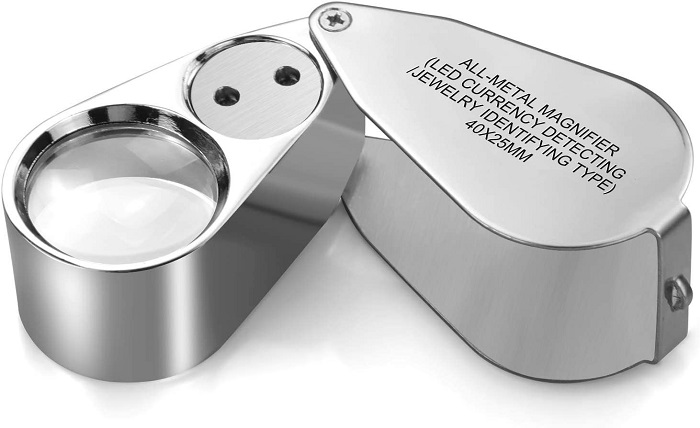How to Choose the Best Coin Magnifier for Your Collection

Coin collecting is a hobby that requires a keen eye for detail, as well as a passion for history and culture. Whether you are a beginner or an expert, you will need a coin magnifier to examine your coins closely and appreciate their features, condition, and authenticity. A coin magnifier is a lens that enlarges the image of an object, making it easier to see the fine details, such as mint marks, errors, varieties, and grades. However, not all coin magnifiers are created equal. There are different types, sizes, shapes, and features of coin magnifiers that suit different needs and preferences. In this blog post, we will help you choose the best coin magnifier for your collection by explaining the main factors to consider and reviewing some of the most popular products on the market.
Magnification Power
The first factor to consider when choosing a coin magnifier is the magnification power, which is the ratio of the size of the image seen through the lens to the size of the object. The higher the magnification power, the larger the image will appear, but also the smaller the field of view and the depth of field. The field of view is the area that you can see through the lens, while the depth of field is the distance range that appears in focus. For example, a 10x magnification power means that the image will appear 10 times larger than the object, but you will only be able to see a small portion of it at a time and it will be blurry if it is too close or too far from the lens.
The ideal magnification power for coin magnifiers depends on your personal preference and the type of coins you collect. Generally speaking, most coin collectors use magnifiers with 5x to 10x magnification power for general inspection and identification of coins, and 15x to 30x magnification power for more detailed examination of errors, varieties, and grades. However, some collectors may prefer higher or lower magnification powers depending on their eyesight, experience level, and coin size. For example, if you collect large coins, such as crowns or dollars, you may not need a high magnification power to see their features clearly. On the other hand, if you collect small coins, such as dimes or cents, you may need a higher magnification power to see their details better.
Lens Quality
The second factor to consider when choosing a coin magnifier is the lens quality, which affects the clarity, brightness, and color accuracy of the image. The lens quality depends on several aspects, such as the material, shape, coating, and number of lenses. The material of the lens determines its durability and resistance to scratches and abrasions. The most common materials for coin magnifiers are glass and plastic. Glass lenses are more durable and provide better clarity and brightness than plastic lenses, but they are also heavier and more expensive. Plastic lenses are lighter and cheaper than glass lenses, but they are also more prone to scratches and distortions.
The shape of the lens determines its optical performance and distortion level. The most common shapes for coin magnifiers are spherical and aspherical. Spherical lenses have a curved surface that is symmetrical in all directions. They are easy to manufacture and provide good magnification power, but they also cause spherical aberration, which is a distortion that makes the image blurry or fuzzy around the edges. Aspherical lenses have a curved surface that is not symmetrical in all directions. They are harder to manufacture and more expensive than spherical lenses, but they also correct spherical aberration and provide better clarity and sharpness across the entire image.
The coating of the lens determines its reflectivity and light transmission. The coating is a thin layer of material that is applied to one or both sides of the lens to reduce glare and enhance contrast. The most common types of coating for coin magnifiers are anti-reflective (AR) coating and multi-coating (MC) coating. AR coating reduces reflections from light sources by allowing more light to pass through the lens. MC coating reduces reflections from both light sources and other lenses by applying multiple layers of different materials with different refractive indices. Both types of coating improve image quality by increasing brightness and color accuracy.
The number of lenses determines its complexity and versatility. The number of lenses refers to how many individual lenses are combined or cemented together to form a single lens unit. The most common types of lenses for coin magnifiers are single lens (SL) lens and doublet lens (DL) lens. SL lens consists of one lens that provides basic magnification power but may also cause chromatic aberration, which is a distortion that makes the image have fringes of different colors around the edges. DL lens consists of two lenses that are cemented together with different materials and curvatures to correct chromatic aberration and provide better image quality.
Additional Features
The third factor to consider when choosing a coin magnifier is the additional features that enhance its functionality and convenience. Some of the most common additional features for coin magnifiers are:
- LED light: A LED light is a light-emitting diode that provides illumination for the object being magnified. A LED light can help you see the details of your coins better in low-light conditions or in dark areas, such as under a table or in a drawer. A LED light can also help you distinguish the colors and tones of your coins more accurately. Some coin magnifiers have built-in LED lights that are powered by batteries or USB cables, while others have detachable LED lights that can be attached to the magnifier or used separately.
- UV light: A UV light is an ultraviolet light that emits radiation with a wavelength shorter than visible light. A UV light can help you detect counterfeit or altered coins by revealing hidden marks, stains, or fluorescence that are not visible to the naked eye. Some coin magnifiers have built-in UV lights that are powered by batteries or USB cables, while others have detachable UV lights that can be attached to the magnifier or used separately.
- Scale: A scale is a measuring device that indicates the size or weight of an object. A scale can help you determine the dimensions and mass of your coins, which are important factors for identification and valuation. Some coin magnifiers have built-in scales that are calibrated in millimeters, inches, grams, or ounces, while others have detachable scales that can be attached to the magnifier or used separately.
- Stand: A stand is a supporting device that holds the magnifier in place over the object being magnified. A stand can help you stabilize the image and reduce hand fatigue when using the magnifier for a long time. Some coin magnifiers have built-in stands that are adjustable in height and angle, while others have detachable stands that can be attached to the magnifier or used separately.
Product Reviews
To help you choose the best coin magnifier for your collection, we have reviewed some of the most popular products on the market based on their magnification power, lens quality, and additional features. Here are our top picks:
- JARLINK 30X 60X Illuminated Jewelers Loupe Magnifier: This is a compact and portable coin magnifier that has two lenses with 30x and 60x magnification power. The lenses are made of glass and have anti-reflective coating to provide clear and bright images. The magnifier also has two LED lights and one UV light that are powered by three LR1130 batteries (included). The LED lights provide illumination for the object being magnified, while the UV light helps detect counterfeit or altered coins. The magnifier has a foldable design that protects the lenses when not in use and fits easily in your pocket or purse. The magnifier also comes with a leather pouch and a cleaning cloth for storage and maintenance. This is a great coin magnifier for beginners and casual collectors who need a simple and convenient tool for general inspection and identification of coins.
- 30X Coin Magnifier: This is a powerful and versatile coin magnifier that has one lens with 30x magnification power. The lens is made of glass and has multi-coating to provide sharp and accurate images. The magnifier also has six LED lights and one UV light that are powered by a rechargeable lithium battery (included). The LED lights have three modes (white light, purple light, and white + purple light) that can be adjusted by a switch on the side of the magnifier. The white light provides illumination for the object being magnified, while the purple light helps detect counterfeit or altered coins. The white + purple light combines both functions for optimal results. The magnifier also has a scale on the lens that measures up to 25 mm in diameter. The scale can help you determine the size of your coins, as well as measure errors and varieties. The magnifier has a metal body that is durable and ergonomic, as well as a metal stand that is adjustable in height and angle. The stand can help you stabilize the image and reduce hand fatigue when using the magnifier for a long time. The magnifier also comes with a USB cable for charging, a cleaning cloth for maintenance, and a user manual for instructions. This is an excellent coin magnifier for intermediate and advanced collectors who need a powerful and versatile tool for detailed examination and authentication of coins.
- TOMLOV 1000X Error Coin Microscope: This is an innovative and professional coin microscope that has one lens with 1000x magnification power. The lens is made of glass and has multi-coating to provide high-resolution images. The microscope also has eight LED lights that are powered by a rechargeable lithium battery (included). The LED lights have two modes (bright light and soft light) that can be adjusted by a knob on the side of the microscope. The bright light provides illumination for the object being magnified.



